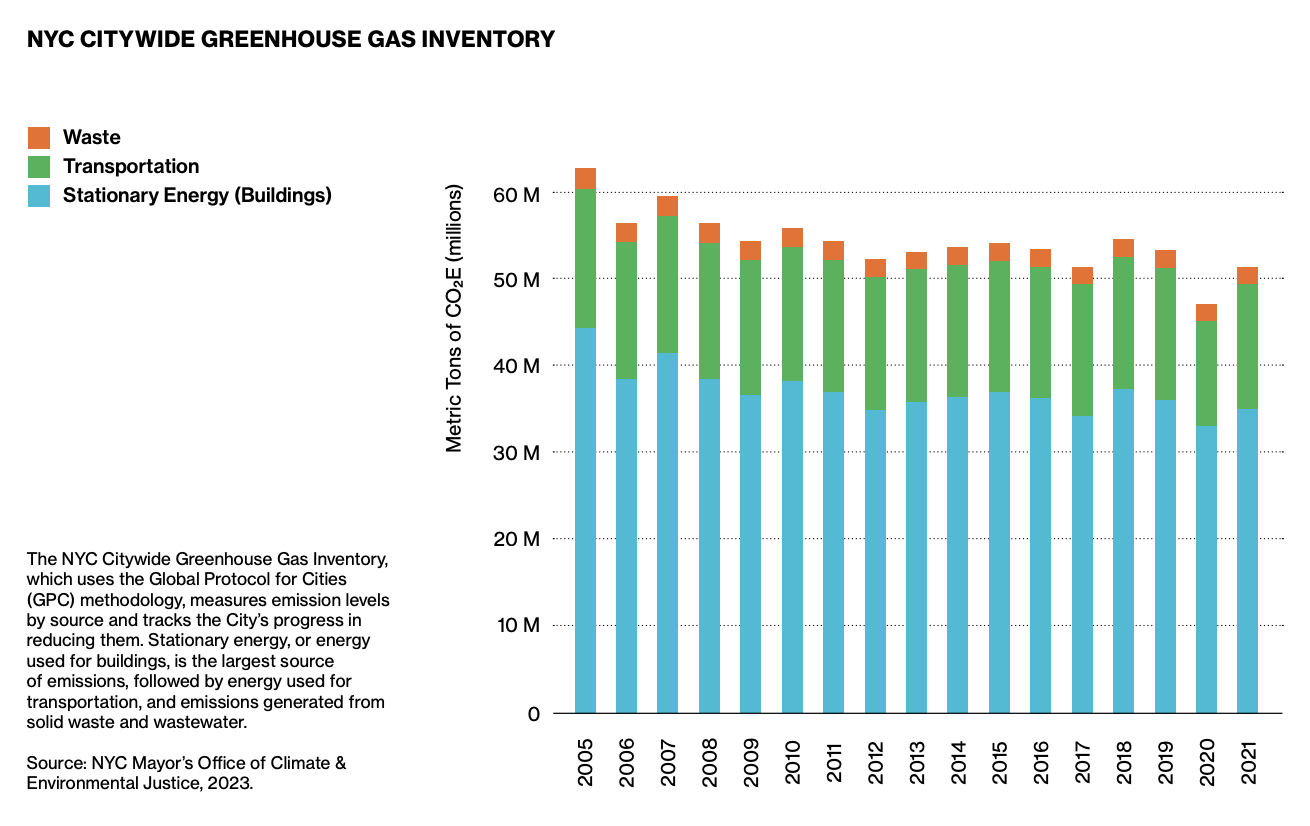Electric Vehicles Adoption and Market in NYC
The 2023 PlaNYC report delineates pivotal strategies aimed at curbing greenhouse gas (GHG) emissions. Within this comprehensive framework, transportation emerges as a focal point alongside building energy consumption, undersoring its indispensable role in realizing environmental sustainability.

Among these strategies, No.23 (Page 53 in the report), titled "Help New Yorkers who must drive to drive electric" clarifies the goals tailored to advance the widespread adoption of electric vehicles (EVs) within NYC diverse transportation landscape, specifically, focusing on personal vehicles, for-hire vehicles, and school bus.
- Ensure every New Yorker is no more than 2.5 miles from an electric vehicle fast charging hub by 2035
- Mandate private parking garages and lots to make electric vehicle charging available by 2030
- Transition taxis and for-hire vehicles to electric vehicles
- Electrify school buses by 2035
The transition from non-renewable energy sources to electric alternatives, particularly for private car owners, represents a monumental shift. Thus, the imperative of educating and promoting EVs assumes paramount importance in facilitating this transition.
Objectives
In this report, I will delve into various datasets to gain insight into the current state of EV adoption within the city. By examining EV ownership preferences, I aim to discern trends regarding car models and features that are most favored by consumers. Given that infrasturcture plays an essential role in facilitating EV adoption, I will also analyze the existing infrasturcture plans related to charging stations. This analysis will encompass an evaluation of accessibility at different levels, especially Level 2 charging stations, ensuring a comprehensive understanding of the equity and opportunities associated with EV infrastructure development.
Electric Vehicle Adoption Patterns Across Neighborhoods
As of 2023, there has been a noticeable increase in EV adoption across the boroughs, with Queens resident displaying a particularly robust demand for EVs, likely due to the high number of car-owning households, as indicated by census survey. This trend gained a boost in 2019 when the pandemic started, with an increasing number of New Yorkers opting for EVs. Conversely, demand in Manhattan experienced a decline at this period. This shift can be attributed to two reasons:
- The enduring reliance on a well-served public transportation network covered by MTA
- Some individuals desire to minimize exposure to Covid-19 by using personal car, with eletric vehicles emerging as an appealing choice.
To gain deeper insights into EV adoption across different areas, the choropleth map showcases the EV density among car-owning households from 2016 to 2023. A striking trend emerges: nearly every zip-code level area witnessed an increase in EV adoption among car-owning households by 2023 compared to EV dessert in 2016. While the adoption may not yet be ubiquitous, a notable shift is evident, with more individuals now considering EV as a viable option. Apparently, certain neighborhoods stand out as key contributors to the city's EV adoption landscape, including FiDi and some East Harlem areas in Manhattan, as well as areas spanning from Long Island City to Flushing in Queens. However, regional disparities persist within the EV market despite overall progress.
EV Market
Battery Electric Vehicles (BEVs)
A BEV runs on electricity alone without gas engine part. Zero emissions. Most BEVs are capable of fast charging and L2 charging. (More)
Plug-in Hybrid Electric Vehicles (PHEVs)
PHEVs use both eletric power (with a larger battery compared with the conventional hybrid) and gas power. A PHEV can travel short distances solely on electric power, while gas-powered engine work as a backup, taking over when the battery becomes depleted. (More)
Overall, the market for both Battery Electric Vehicles (BEVs) and Plug-in Hybrid Electric Vehicles (PHEVs) exhibits a diverse array of car models over time. Among BEVs, Tesla and Chevrolet emerge as prominent players, with models such as the Model 3, Model Y from Tesla, and the Bolt EV from Chevrolet having considerable attention from the residents. Additionally, KIA, a South Korean automaker, has gained traction in recent years. While the PHEV market in the city receives less attention compared to BEVs, it still satisfies the needs of certain customers who require long-distance travel capabilities. Noteworthy choices in the PHEV segment include the Prius Prime from Toyota and the Fusion from Ford, which are favored by New Yorkers.
Download Excel Workbook to lookup All-Electric Vehicles Model and Fuel Economy Information
How the City Can Facilitate EV Adoption
Purchase Promotion Offered by Government:
NYS Drive Clean Rebate For Elctric Car Program
Investment in EV infrastructure:
ensuring that adequate infrastructure is available in all neighbourhoods. So far, EV models from Tesla contribute a lot in the market across the Borough.
One of the reason is their huge charging network around the city.
Summary
To summarize, unlike the electric vehicles dessert several years ago, many New Yorkers start turning focus on EV market. In particular, residents in Queens are getting pay more attention on EVs. And Tesla play a significant role in market share. While progress is evident in the transition to EVs, addressing regional disparities remains a pressing challenge.
Infrastructure emerges as a crucial factor in facilitating this transition. However, the affordability of EVs stands out as a major deterrent, particularly for individuals from low to moderate-income households. Without achieving a balance between EV supply and demand, the disparities in adoption rates and charging station accessibility are poised to widen.
Beyond personal vehicles, prioritizing electrification across various vehicle types, such as taxis and for-hire vehicles, is imperative given the city's reliance on public transportation, which is essential for reducing emissions effectively.
Next Step: EV Infrastructure
Based on NYCDOT Level 2 Pilot Program Report, EV Infrastructure Accessibility and Equity